Click above to view a high-res gallery of the Hyundai Genesis Coupe
Here it is, the 2009 Hyundai Genesis Coupe. We can hardly contain our enthusiasm over this car. On the one hand, Hyundai is offering enthusiasts the only rear-wheel-drive coupe on the market powered by a turbocharged four-cylinder (not all of us want our hair ruffled in RWD four-cylinder convertibles like the Mazda MX-5, GM's Kappa convertibles and the Honda S2000). While on the other, it's also debuting a RWD coupe powered by a 306-horsepower 3.8L V6 (310 hp when drinking premium) that should undercut all similarly powered competition by thousands of dollars. The Genesis Coupe is a win-win car no matter which engine you choose.
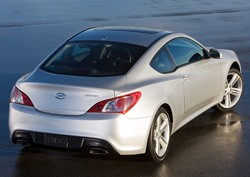 The Genesis Coupe also features one of Hyundai's most original designs that's an evolution of its HCD concepts. All the lines up front slope, curve and bend down to the center of the lower air intake, creating a wind-swept look that's more JDM than American Muscle. The car's defining design element, however, is the "Z" that's created when two dynamic character lines run parallel across the doors from either end of the coupe. The sheetmetal around the front and rear fenders twists like someone is wringing water out of the car, which adds both volume and a sense of kinetic energy being stored in the muscular body panels. The car's profile, however, mimics that of the Nissan Altima Coupe, while the rear, especially the taillights, seem like inevitable conclusions of the car's design rather than striking elements on their own. And we still think the side windows behind each door that dip down below the belt-line is a nice, functional idea, as well as a quirky aspect that will become the design's trademark.
The Genesis Coupe also features one of Hyundai's most original designs that's an evolution of its HCD concepts. All the lines up front slope, curve and bend down to the center of the lower air intake, creating a wind-swept look that's more JDM than American Muscle. The car's defining design element, however, is the "Z" that's created when two dynamic character lines run parallel across the doors from either end of the coupe. The sheetmetal around the front and rear fenders twists like someone is wringing water out of the car, which adds both volume and a sense of kinetic energy being stored in the muscular body panels. The car's profile, however, mimics that of the Nissan Altima Coupe, while the rear, especially the taillights, seem like inevitable conclusions of the car's design rather than striking elements on their own. And we still think the side windows behind each door that dip down below the belt-line is a nice, functional idea, as well as a quirky aspect that will become the design's trademark.
It's all about the engines though, so follow the jump to learn more about the Hyundai Genesis Coupe. We're literally at the press conference right now taking photos and video, which promise to be epic, so check back soon.
Here it is, the 2009 Hyundai Genesis Coupe. We can hardly contain our enthusiasm over this car. On the one hand, Hyundai is offering enthusiasts the only rear-wheel-drive coupe on the market powered by a turbocharged four-cylinder (not all of us want our hair ruffled in RWD four-cylinder convertibles like the Mazda MX-5, GM's Kappa convertibles and the Honda S2000). While on the other, it's also debuting a RWD coupe powered by a 306-horsepower 3.8L V6 (310 hp when drinking premium) that should undercut all similarly powered competition by thousands of dollars. The Genesis Coupe is a win-win car no matter which engine you choose.
 The Genesis Coupe also features one of Hyundai's most original designs that's an evolution of its HCD concepts. All the lines up front slope, curve and bend down to the center of the lower air intake, creating a wind-swept look that's more JDM than American Muscle. The car's defining design element, however, is the "Z" that's created when two dynamic character lines run parallel across the doors from either end of the coupe. The sheetmetal around the front and rear fenders twists like someone is wringing water out of the car, which adds both volume and a sense of kinetic energy being stored in the muscular body panels. The car's profile, however, mimics that of the Nissan Altima Coupe, while the rear, especially the taillights, seem like inevitable conclusions of the car's design rather than striking elements on their own. And we still think the side windows behind each door that dip down below the belt-line is a nice, functional idea, as well as a quirky aspect that will become the design's trademark.
The Genesis Coupe also features one of Hyundai's most original designs that's an evolution of its HCD concepts. All the lines up front slope, curve and bend down to the center of the lower air intake, creating a wind-swept look that's more JDM than American Muscle. The car's defining design element, however, is the "Z" that's created when two dynamic character lines run parallel across the doors from either end of the coupe. The sheetmetal around the front and rear fenders twists like someone is wringing water out of the car, which adds both volume and a sense of kinetic energy being stored in the muscular body panels. The car's profile, however, mimics that of the Nissan Altima Coupe, while the rear, especially the taillights, seem like inevitable conclusions of the car's design rather than striking elements on their own. And we still think the side windows behind each door that dip down below the belt-line is a nice, functional idea, as well as a quirky aspect that will become the design's trademark.
It's all about the engines though, so follow the jump to learn more about the Hyundai Genesis Coupe. We're literally at the press conference right now taking photos and video, which promise to be epic, so check back soon.
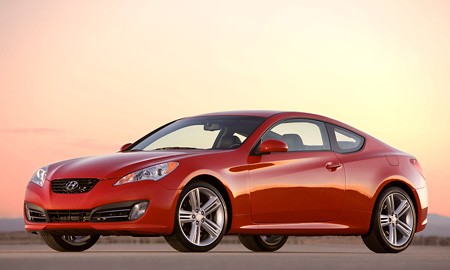
But you want numbers, so here we go. Order the Hyundai Genesis Coupe (available by Spring of 2009) with the four-cylinder and you'll get an all-aluminum DOHC turbocharged 2.0L mill with continuously variable valve timing on both the intake and exhaust producing 212 horsepower (223 on premium fuel!) and 217 pound-feet of torque. For comparison's sake, that's two more horsies than the 210-horsepower Ford Mustang V6, though the Mustang does produce a lot more torque at 240 pound-feet. Unfortunately, being down two cylinders doesn't translate into a lower curb weight, as the 3,439-lb. Genesis Coupe is some 139 lbs. heavier than the 'Stang.
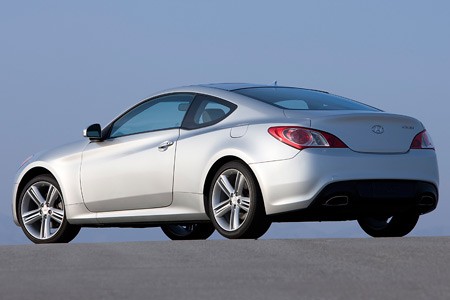
And then there's the V6 model. It's Hyundai's familiar all-aluminum DOHC 3.8L V6, also with variable valve timing though only on the intake side. In the Genesis Coupe, this engine produces the aforementioned 306 horsepower and 263 pound-feet of torque at 4,700 RPM. A Ford Mustang GT equipped with a 4.6L V8 produces 300 horsepower and 320 foot-pounds of torque. With the V6, the Genesis Coupe actually weighs a few pounds less than the Mustang GT (3,549 lbs. to 3,518), so performance should be comparable.
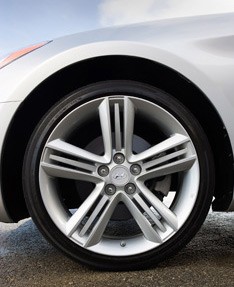 Both models of the Genesis Coupe feature a MacPherson strut dual-link front suspension and a five-link rear suspension, which are connected to your choice of 18- or 19-inch wheels. Transmission choices are limited to a six-speed manual as standard equipment for both cars, or a five-speed auto for the four-cylinder model and a ZF six-speed slushbox for the V6.
Both models of the Genesis Coupe feature a MacPherson strut dual-link front suspension and a five-link rear suspension, which are connected to your choice of 18- or 19-inch wheels. Transmission choices are limited to a six-speed manual as standard equipment for both cars, or a five-speed auto for the four-cylinder model and a ZF six-speed slushbox for the V6.
The interior of the Genesis Coupe is also a departure for Hyundai, featuring switchgear and components that we've never seen before from this South Korean car company. The center console is angled slightly towards the driver and finished in hard silver plastic that contrasts with the matte black palette of plastics and leather elsewhere in the interior. There's a push-button start, large speedo and tachometer front and center, multi-function steering wheel, and nicely bolstered seats. An information display that's smaller than a nav screen but larger than a traditional LCD stereo display sits atop the dashboard, but there's no word on whether a navigation system will be offered, as well. We're trying to clamor into the back seat of this 2+2 as we speak, so more on that later.
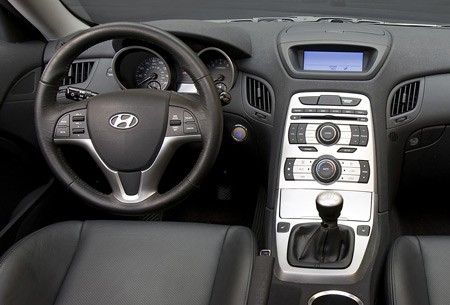
Though pricing hasn't been announced, we expect the Hyundai Genesis Coupe to undercut most of the cars against which it will inevitably be compared. That includes the aforementioned Mustang, as well as such varied vehicles as the Infiniti G37, Mitsubishi Eclipse, Mazda RX-8, and even the Dodge Challenger and forthcoming Camaro from Chevy. While a V8 is not available, the 3.8L V6 is plenty powerful and frankly we're more interested in the turbo-four and its tuner potential. Will this be a game-changing car for Hyundai? Does the Genesis Coupe measure up as more than just a good value? We'll let you be the judge until we get to drive one ourselves.
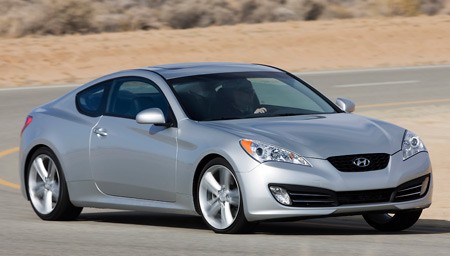
The video meant to be presented here is no longer available. Sorry for the inconvenience.
The video meant to be presented here is no longer available. Sorry for the inconvenience.
PRESS RELEASE:
ALL-NEW HYUNDAI GENESIS COUPE: A NEW BENCHMARK FOR AFFORDABLE 300-HORSEPOWER SPORTS COUPES
NEW YORK, March 19, 2008 – Hyundai unveiled Genesis Coupe, a new benchmark for affordable 300-horsepower sports coupes, during a press conference at the New York International Auto Show today. The 2010 Genesis Coupe is a purpose-built rear-wheel drive sports coupe featuring two performance-focused engines – a 212-horsepower 2.0-liter turbocharged four-cylinder engine and a range-topping all-aluminum 306-horsepower, DOHC 3.8-liter V6 engine. Genesis Coupe is scheduled to join the Hyundai lineup in the spring of 2009.
Following the introduction earlier this year of the rear-wheel drive Genesis sports sedan, Genesis Coupe is Hyundai's most dynamic performance car ever and the second consecutive all-new model introduction from Hyundai appealing directly to the car enthusiast. Genesis Coupe uses the same flexible rear-wheel drive architecture that was originally developed for the Genesis sports sedan.
Genesis Coupe employs a MacPherson strut dual-link front suspension and a five-link rear suspension setup. Both engines are mated to a standard six-speed manual transmission. The Genesis Coupe 2.0t (2.0-liter 4-cylinder turbo) offers an optional five-speed automatic with SHIFTRONIC® while the 3.8-liter V6 offers a ZF six-speed automatic transmission with SHIFTRONIC to handle the additional torque.
"We think our entry-level Genesis Coupe 2.0t, with its unique combination of rear-wheel drive and four-cylinder turbo power, offers an intriguing alternative to existing front-wheel drive sports coupes," said John Krafcik, vice president, product development and strategic planning, Hyundai Motor America. "The 3.8-liter version of Genesis Coupe takes things to an even higher level, rivaling the capability of premium-performance coupes like Infiniti G37."
Genesis Coupe was shown as a concept at the 2007 Los Angeles Auto Show and its transformation from concept to production reveals that its signature design features have emerged intact. Genesis Coupe is also unmistakably linked to several Hyundai concept cars. The powerful curves, surface detail, and "Z" bodyside lines come straight from the HCD9 Talus and the HCD8 sports coupe. Genesis Coupe's arching roofline and tapering greenhouse highlight the exterior profile and emphasize the car's broad shoulders and wide stance. Genesis Coupe rides on standard 18-inch alloy wheels or optional 19-inch wheels, both delivering a bold stance and aggressive handling.
In keeping with its mission to be the most exciting, affordable sports coupe on the road, the Genesis Coupe boasts a cockpit designed to enhance the driving experience. An information display screen, features an outside temperature reading, audio system information and HVAC settings. Analog gauges include a large speedometer and tachometer positioned so the driver can immediately access critical driving information. The instrument cluster features Hyundai's signature blue gauge illumination.
Music lovers will welcome the inclusion of standard auxiliary input jacks (3.5 mm mini-jack and USB input) to accommodate and charge audio devices such as iPods®. Among the other refinements are an Infinity audio system, sport bucket seats and two-stage front seat warmers. Genesis Coupe also offers the convenience of a proximity key and push button starter.
The 2010 Genesis Coupe includes a wide range of both active and passive safety features. Standard safety equipment includes driver and front passenger advanced frontal airbags, along with front seat-mounted side airbags, side air curtains, active front head restraints, four-channel ABS with Electronic Brake-force Distribution (EBD), and Electronic Stability Control (ESC), one of the industry's most effective life-saving technologies.
GENESIS COUPE SPECIFICATIONS
Configuration: Front engine, rear-wheel drive
Wheelbase: 2820 mm / 111.0 inches
Overall length: 4630 mm / 182.3 inches
Overall width: 1865 mm / 73.4 inches
Overall height: 1380 mm / 54.3 inches
Wheels: 18-inch or 19-inch five-spoke
Engine types: 3.8-liter V6 or 2.0-liter 4-cylinder turbo
Est. horsepower V6: 306 @ 6,000 rpm (regular fuel)
Est. horsepower V6: 310 @ 6,000 rpm (premium fuel)
Est. torque V6: 263 lb. ft. @ 4,700 rpm (regular and premium fuel)
Est. horsepower 2.0t: 212 @ 6,000 rpm (regular fuel)
Est. horsepower 2.0t: 223 @ 6,000 rpm (premium fuel)
Est. torque 2.0t: 217 lb. ft. @ 2,500 rpm (regular and premium fuel)
Block & head materials: aluminum for both engines
Valvetrain: DOHC for both engines
Valve timing: continuously variable valve timing for both engines (Dual for 2.0t)
Estimated 0-60 mph V6: under 6 seconds
Transmission types: 6-speed manual, 5-speed automatic (4-cylinder) or 6-speed manual, 6-speed automatic (V6)
Front brakes: 12.6-inch (standard) 13.4-inch (Brembo package)
Rear brakes: 12.4-inch (standard) 13.0-inch (Brembo package)
Front calipers: single piston floating (standard), monobloc four-piston (Brembo package)
Rear calipers: single piston floating (standard) monobloc four-piston (Brembo package)
Limited slip differential (Optional)
Est. top speed: 149 mph (V6), 137 mph (2.0t)
Base curb weight: 3549 lbs. (V6); 3439 lbs. (4-cylinder)
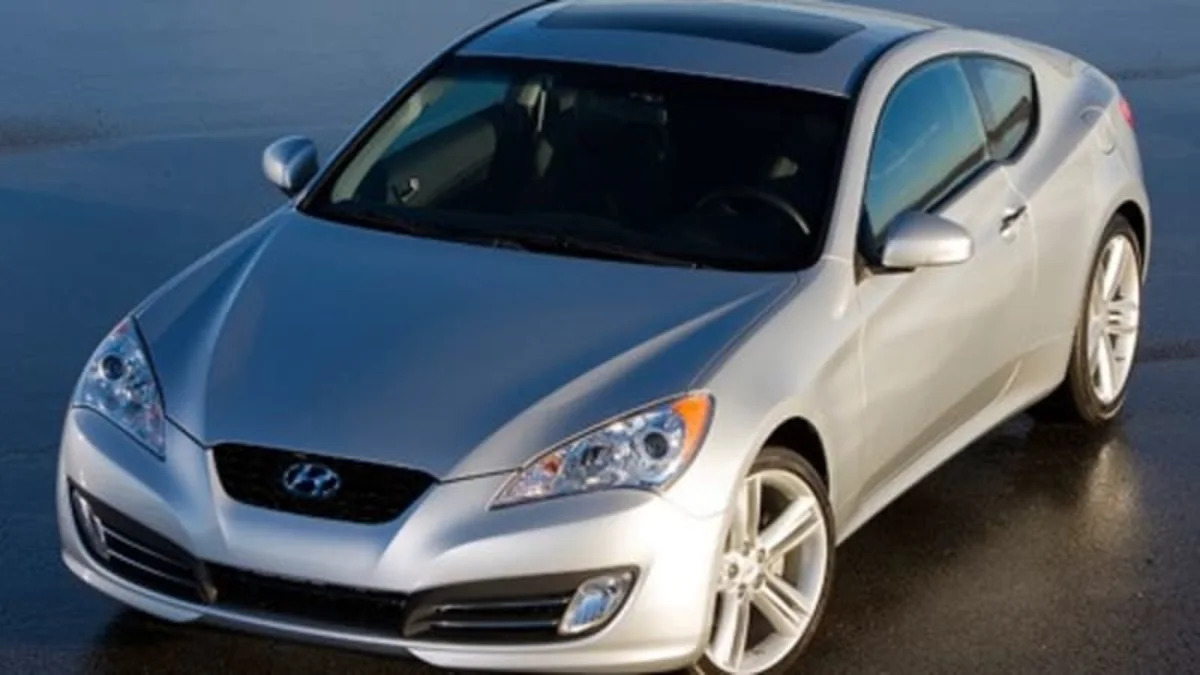
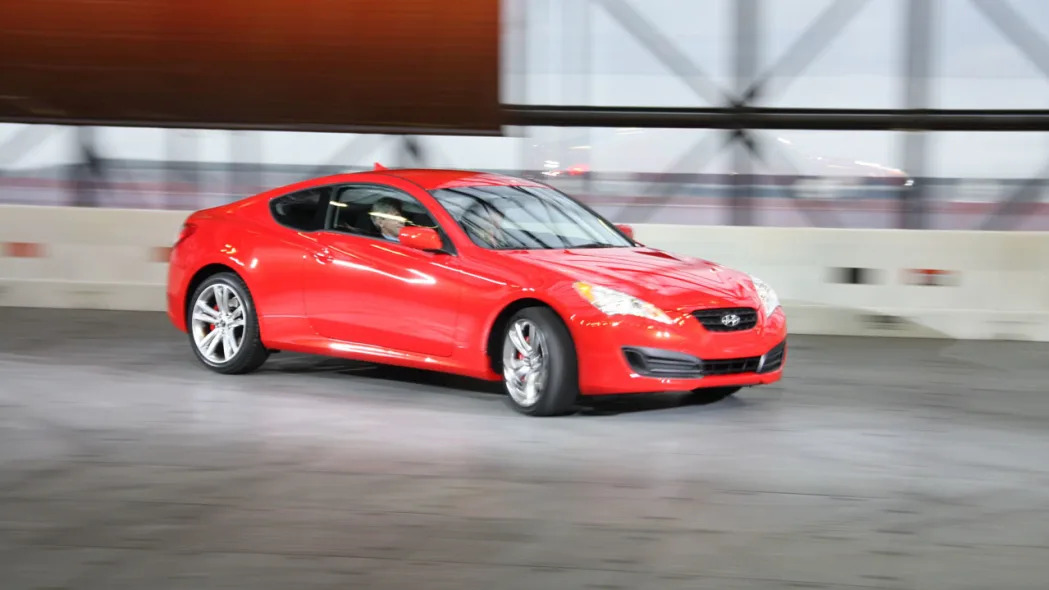

Sign in to post
Please sign in to leave a comment.
Continue